The index to the Comics and Music roundtable is here.
______________________
Comics and music may relate in a few ways: musicians and their music may be cited in comics (as seen below); abstract forms and colors, organized in patterns in a comic, may be associated with music as Wassily Kandinsky theorized; comics artists themselves may be musicians (Fort Thunder) linking their two creative activities together like Geneviève Castrée.
Gato Barbieri in Muñoz and Sampayo’s first album/graphic novel (seen on the background as Changuitos – boys – jujeños – from Jujuy), Perché lo fai, Alack Sinner? (why do you do it, Alack Sinner?) “Viet Blues” episode, Milano Libri, 1976. Famous Argentinian jazz musician Gato Barbieri is singing the lyrics of El arriero (the muleteer) by Atahualpa Yupanqui [“plights and cows follow the same pathway, plights are ours, cows are someone else’s.” By citing Barbieri citing Yupanqui Muñoz and Sampayo make a clear left-wing political statement. You can hear Barbieri playing and singing, here (5.20)].
Since her almost wordless beginnings in 2000 with Lait frappé (milk-shake – L’Oie de Cravan) and Die Fabrik (the factory – Reprodukt) that Geneviève Castrée showed little inclination towards the orthodox storytelling so prevalent in the comics industry. Her comics are dreamlike, mysterious, symbolic, barely narrative.
Geneviève Castrée, Lait frappé, L’ Oie de Cravan, 2000.
Geneviève Castrée, Die Fabrik, Reprodukt, May 2002.
After publishing her third book (Roulathèque Roulathèque Nicolore, L’Oie de Cravan, 2001), Geneviève Castrée published Pamplemoussi (grapefruit). Here’s what she has to say about it:
I wanted to make a book with a record for years. One day I was looking out the window of my studio and I decided to start writing songs for the stories. It took me a lot more time than I was used to and when it came out I went on tour for a few months. I never had enough copies and there are none left. It was published in 2004 by L’Oie de Cravan.
Pamplemoussi is a large square book (obviously, it has the form and size of the vinyl LP record that comes with it – or is it the other way around?). Just for a taste, and because that’s what I found on You Tube, here’s one of the songs:
Geneviève Castrée, “Chanson pour les guêpes,” Pamplemoussi, L’Oie de Cravan, 2004.
Geneviève’s drawing style could be part of a long tradition of children’s books illustration, but, if we read between the lines, her comics are about abusive relationships, depression, solipsism, etc… In other words, they’re not unlike all good children’s books, of course… In Lait frappé, for instance, a series of episodes with titles in Russian (god knows why!?) describe a journey from low self-esteem and self-hate to the desire of changing people (anonymous black cats) in order to suit them for our purposes (as seen in a dream in which Geneviève portrays herself as an evil sorceress transforming black cats into white milk in order to drink it) to a relationship with a self-defensive abusive cat (she tries to drink from a milk bottle with a broken neck that she finds on the street just to cut her lip). All this told in clever visual figures of speech in 27 pages only. No doubt about it: Lait frappé is a little comics masterpiece that deserves to be reprinted increasing its original print run of 350.
Geneviève Castrée, “The Fire In Mr. Pea,” Kramers Ergot # 4, Avodah Books, 2003.
Geneviève Castrée (signing as Geneviève Elverum – her husband’s last name), cover for Drawn & Quarterly Showcase # 3, July 2005. The cover alludes to “We’re Wolf,” another great improv about awkward relationships in a beautifully illustrated story inspired by Hergé’s Tintin in Tibet.
Geneviève Castrée, Susceptible, Drawn & Quarterly, 2012. Geneviève’s more recent book. [Maybe it will be the object of a future Stumbling, who knows?]
Pamplemoussi explores the same themes already mentioned above, but the relations between the song lyrics, the (minimal) music, the incantatory tone and the symbolic drawings are even more allusive and elusive. There’s a song about feeling uncomfortable in one’s body (“Chanson pour la géante” – “Song for the girl giant” [sic]) and another one for vanquishing one’s fears (“Chanson pour les guêpes” – “Song for the wasps” – listen above) and yet another one about how limited we are in the little boxes of our minds; how we futilely dream of escaping (“Chanson pour la hase” – “Song for the hare”). Since solipsism is so important in Geneviève’s work, I’ll let you with the part of this last song’s lyrics in English (as translated in Pamplemoussi) which explains why there’s no escape. I’ll let you also with another song by Geneviève Castrée… just because I like it this time…
some animals dream/ of countries, of planets and stars/ of which they only know details;/ adopted and spied from conversations/ they were not part of/ it is to wonder/ if they know that in other countries/ people are just as mean/ on a different planet/ you suffocate/ and before reaching the stars/ you burn/
Woelv [Geneviève Castrée], “Gris”, from the album Gris, P. W. Elverum and Sun Ltd., 2006.
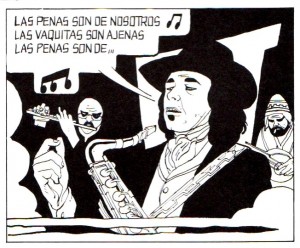

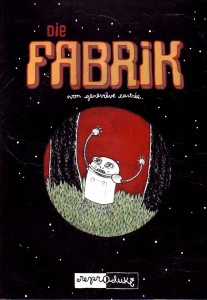
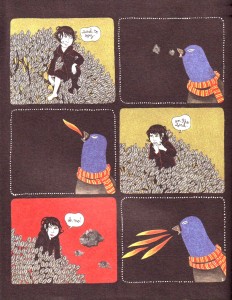
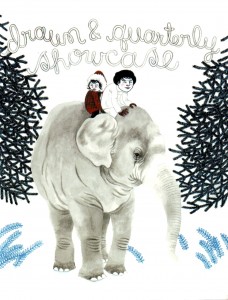
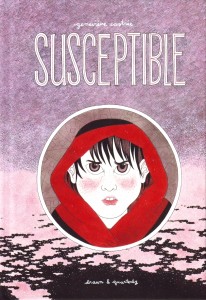
Those images are really poignant and evocative. Which has nothing to do with remembering the only cartoon book I ever got that came with a record, which was Berke Breathed’s “Billy and the Boingers Bootleg.”
My first one came with an audio cassette (anyone remembers those anymore?). It was Kyle Baker’s Break the Chain (published in 1994!). Almost 20 years ago déjà!
I love this small, but great, or greatly small Pamplemoussi review.
I remember the flexidisk (“Precambrian Bath”) I got in Gary Panter’s Invasion of the Elvis Zombies (1984)! I wonder who swiped that…
Nice review, Domingos. I remember looking for Lait frappé when I first encountered Castrée’s work in, I think, D&Q Showcase. Still no luck today, but you make me want a copy more than ever.
Thanks Peter!
There’s also one of those in Raw # 4, I think.
Yup, Lait frappé is great, but I guess that 1 of 350 in existence must be a bit difficult to find at this point. Maybe Chris Oliveros will publish all of Geneviève’s work in one (not even that thick) volume.
You’re right about RAW #4 — the first issue I bought off the stands and a real game-changer for me. That disc, “Reagan Speaks for Himself,” was odd: a remix of snippets from an interview with the then-candidate. (Although they probably didn’t call it a remix.)
My only memories from it: “take the backbone of America and then break it” and “a can of poison meat.”
Come to think of it, that one is missing too!
What the world takes, the Internet provides:
http://diymedia.net/audio/mp3/dougkahn-reaganspeaks.mp3
That’s great! Thanks again, Peter!
But is there a connection with Dawn Nataly’s band Pomplamoose?
http://www.ilxor.com/ILX/ThreadSelectedControllerServlet?action=showall&boardid=41&threadid=85037
None whatsoever…
I’m not sure if the timing of this archive re-post was conscious or not, but I found it very moving to see it here so soon after Geneviève’s passing, on the same page that also informs that the HU is transitioning. Thanks to Noah and many others for creating and sustaining this space to meet, read, think and talk about creation and creations. Best wishes in all the new things, Noah. And, as for Geneviève’s passing, fuck you Death.
Yes, Domingos suggested I post this week since she died. The blog ending at the same time is just coincidence, though…
And thank you Bryce. Hope you’re well.